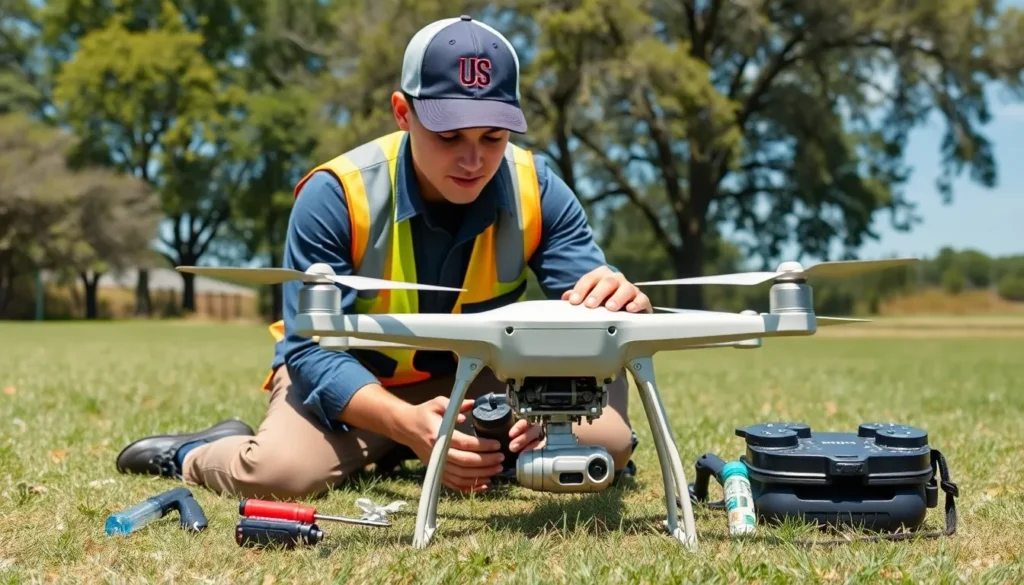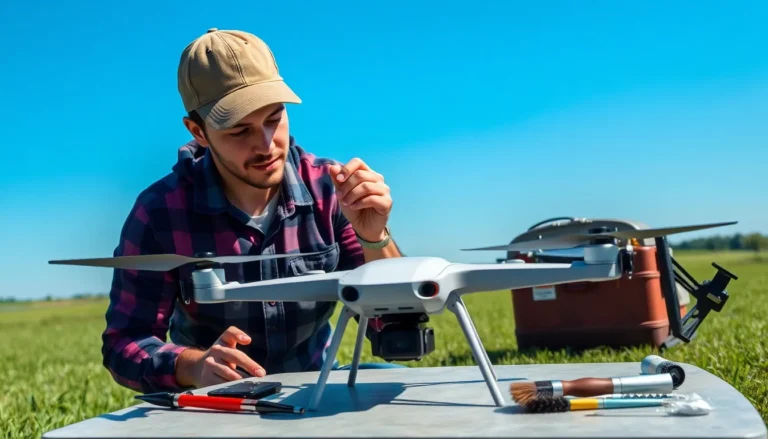In the world of drones, keeping them airborne is only half the battle. Just like a car needs oil changes and a dog needs regular walks, drones crave maintenance to perform their aerial acrobatics. Imagine sending your drone on a mission only for it to sputter out mid-flight, leaving you with a sinking feeling and a very expensive paperweight.
Table of Contents
ToggleOverview of Drone Maintenance Schedules
Regular maintenance schedules are essential for maximizing the lifespan of drones. Operators rely on systematic checks to ensure each component functions optimally. Scheduled inspections focus on battery health, motor performance, and overall structural integrity.
Adhering to a maintenance timeline can prevent critical failures. For instance, replacing batteries every 20 to 30 flight hours can enhance safety. Following manufacturer guidelines provides additional insights into necessary upkeep practices.
Routine cleaning is part of the schedule that shouldn’t be overlooked. Dust and debris can hinder performance, particularly in sensors and propellers. Scheduled cleanings should occur after every 10 flights or more frequently in dusty environments.
Operators should track maintenance activities meticulously. Logbooks documenting inspections and repairs help identify patterns over time. Analyzing this data can pinpoint recurring issues, allowing for proactive measures.
Specific components may require unique maintenance intervals. For example, propellers might need inspection after every flight. Similarly, firmware updates should occur every few months to ensure optimal functionality.
Scheduling downtime for drones is vital for conducting thorough evaluations. Time spent off the field for maintenance can prevent more extensive repairs later. Allocating dedicated maintenance days enhances reliability and efficiency.
Establishing a drone maintenance checklist can streamline processes. Important tasks include tightening screws, checking firmware, and inspecting wiring. Completing each task will ensure operators maintain a high standard of performance.
Following these guidelines fosters a safer and more effective flying experience.
Importance of Regular Maintenance

Regular maintenance plays a critical role in ensuring drone reliability and performance. Prioritizing consistent upkeep prevents failures that can compromise safety.
Safety Considerations
Ensuring safety starts with routine inspections. Checking crucial components like propellers, batteries, and motors mitigates risks. For example, operators should examine propellers after every flight. Identifying wear and tear early can prevent accidents during operation. Many manufacturers recommend following specific guidelines for maintenance timelines. Adhering to these schedules helps maintain structural integrity, significantly reducing the chances of mid-flight failures. Tracking maintenance activities in logbooks promotes accountability and aids in troubleshooting issues effectively.
Performance Optimization
Optimization hinges on regular check-ups and updates. Conducting systematic evaluations helps maintain optimal battery health and motor performance. For instance, replacing batteries after every 20 to 30 flight hours ensures reliable power delivery. Routine cleanings after every 10 flights enhance overall efficiency, keeping the drone in peak condition. Additionally, performing firmware updates every few months sharpens functionality and may introduce necessary fixes. Utilizing a detailed maintenance checklist can streamline this process, allowing operators to identify areas needing attention promptly, which ultimately enhances flight performance.
Types of Maintenance Tasks
Regular maintenance tasks are essential for optimal drone performance. Operators can categorize these tasks into daily inspections and periodic maintenance.
Daily Inspection Checklist
Each flight requires a thorough inspection. Visual checks of the drone’s propellers, ensuring no damage is visible, begin the process. The battery must be examined for any signs of swelling or irregularities. Next, operators assess the motors for unusual noises that might indicate underlying issues. Calibration of sensors is pivotal before each flight to maintain accuracy. Finally, ensuring secure connections for all components solidifies operational readiness.
Periodic Maintenance Tasks
Scheduling routine tasks is crucial for long-term drone durability. Every 10 flights, operators should clean the propellers and airframe to remove debris. Approximately every 20 to 30 flight hours, a detailed check of the battery health and motor performance becomes necessary. Inspections of the drone’s software, including firmware updates every few months, help sustain optimal functionality. Keeping logs of maintenance activities allows for easy tracking of recurring problems, guiding future maintenance decisions. Each of these tasks contributes significantly to the drone’s overall reliability and safety.
Developing a Maintenance Schedule
Creating a maintenance schedule enables drone operators to ensure optimal performance and longevity. Systematic upkeep minimizes the risk of failures and maintains safety during flights.
Factors to Consider
Operators should assess various elements when developing a maintenance schedule. Drone specifications often dictate unique requirements, making it essential to consult manufacturer guidelines. Daily usage frequency plays a role; more intensive use necessitates more rigorous checks. Consider environmental conditions as well. Operating in dusty or wet environments may require additional cleaning and inspections. Components such as batteries, motors, and propellers frequently fluctuate in their maintenance needs, and tracking specific usage patterns assists in predicting when these components will require attention.
Recommended Frequency
Establishing a frequency for maintenance is vital for effective upkeep. Daily inspections should include visual checks of propellers and securing connections before flying. Propellers and airframes demand cleaning every 10 flights. For component checks, operators should evaluate batteries and motors every 20 to 30 flight hours. Software updates, including firmware checks, ought to occur quarterly or as needed. Maintaining detailed logs aids in tracking these schedules to prevent potential issues and ensure efficient operations.
Tools and Resources for Maintenance
Operators require specific tools and resources to ensure effective drone maintenance. A comprehensive toolkit should include a screwdriver set to assist with battery replacements and component adjustments. Additionally, propeller balancing tools help maintain optimal flight performance by ensuring that each propeller rotates evenly.
Logbooks serve as essential resources for tracking maintenance activities and identifying recurring issues. Operators benefit significantly when they log every maintenance task, including inspections and replacements. Digital maintenance trackers can streamline this process, offering reminders for scheduled checks and updates.
Cleaning supplies are crucial for routine maintenance. Operators need microfiber cloths for gentle cleaning of sensitive components and brushes for removing debris from motors and propellers. Using a non-corrosive cleaner specifically designed for drones protects sensitive parts and prevents damage.
Software applications play a vital role in maintaining optimal performance. Firmware update tools ensure drones run on the latest software, enhancing reliability and functionality. Some manufacturers provide mobile apps that offer step-by-step maintenance guides to simplify the process.
For component inspections, torque wrenches help ensure that screws and fittings are secure without causing damage. Multimeters aid in assessing battery health by measuring voltage and current, allowing operators to monitor performance closely.
Lastly, operators benefit from access to online forums dedicated to drone maintenance. Engaging with a community of drone enthusiasts fosters knowledge sharing and provides valuable insights on best practices and troubleshooting techniques. Maintaining a well-equipped toolkit and leveraging available resources is crucial for successful drone upkeep, enabling safer and more efficient flights.
Regular maintenance is vital for ensuring the reliability and longevity of drones. By adhering to a structured maintenance schedule and performing routine inspections, operators can significantly reduce the risk of mid-flight failures. Utilizing a detailed checklist not only streamlines the maintenance process but also promotes optimal performance.
Investing time in regular checks and maintaining a well-equipped toolkit pays off in safer and more efficient flights. Tracking maintenance activities through logbooks or digital tools helps identify patterns and recurring issues, allowing for proactive measures. Ultimately, a commitment to drone upkeep ensures that operators can enjoy the full benefits of their technology while minimizing potential disruptions.










